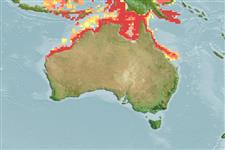Ελασμοβράγχιοι (καρχαρίες και σαλάχια) (sharks and rays) >
Rhinopristiformes (Shovelnose rays) >
Rhinidae (Wedgefishes)
Etymology: Rhynchobatus: Greek, rhingchos = snout + Greek, batis, -idos = a sting ray (Raja sp.) (Ref. 45335); palpebratus: Name from Latin 'palpebra' meaning eyelid, refers to the dark, eyebrow-like marking on the supraorbital membrane..
More on authors: Compagno & Last.
Environment: milieu / climate zone / depth range / distribution range
Οικολογία
Θαλασσινό(ά) βενθικό(ς); εύρος βάθους 5 - 61 m (Ref. 76954). Tropical; 5°S - 23°S, 113°E - 154°E (Ref. 114953)
Indo-West Pacific: Eastern Indian Ocean and South-West Pacific; northern Australia and Papua New Guinea (Ref. 114953).
Μέγεθος / Βάρος / Age
Maturity: Lm ? range ? - ? cm
Max length : 262 cm TL αρσενικό/απροσδιόριστο; (Ref. 114953)
A poorly known benthic species that occurs in shallow water on the continental shelf. Presumably feeds on bottom-dwelling fishes and crustaceans. Males sexually mature at 103 cm TL (Ref. 114953).
Life cycle and mating behavior
Maturities | Αναπαραγωγή | Spawnings | Egg(s) | Fecundities | Προνύμφες
Compagno, L.J.V. and P.R. Last, 2008. A new species of wedgefish, Rhynchobatus palpebratus sp. Nov., (Rhynchobatoidei: Rynchobatidae), from the Indo-West Pacific. In Last, P.R., White, W.T. & Pogonoski, J.J. (eds.): Descriptions of New Australian Chondrichthyans. CSIRO Marine and Atmospheric Research Paper no. 22. (Ref. 76954)
IUCN Red List Status (Ref. 130435)
Threat to humans
Harmless
Human uses
Εργαλεία
Special reports
Download XML
Διαδικτυακές πηγές
Estimates based on models
Preferred temperature (Ref.
123201): 24.6 - 28.8, mean 27.6 °C (based on 504 cells).
Phylogenetic diversity index (Ref.
82804): PD
50 = 0.5049 [Uniqueness, from 0.5 = low to 2.0 = high].
Bayesian length-weight: a=0.00372 (0.00166 - 0.00830), b=3.11 (2.91 - 3.31), in cm total length, based on LWR estimates for this (Sub)family-body shape (Ref.
93245).
Τροφικό Επίπεδο (Ref.
69278): 3.6 ±0.6 se; based on size and trophs of closest relatives
Fishing Vulnerability (Ref.
59153): Very high vulnerability (90 of 100).
